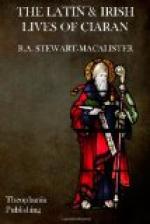Ciaran of Clonmacnois was not the only saint of that name. Besides his well-known namesake of Saighir (Seir-Kieran, King’s Co.), there were a few lesser stars called Ciaran, and there is danger of confusion between them. The name reappears in Cornwall, with the regular Brythonic change of Q to P, in the form Pieran or Pirran. This Pieran is wrongly identified by Skene[8] with our saint; a single glance at the abstract of the Life of St. Pieran given by Sir T.D. Hardy[9] will show how mistaken this identification is. A similar confusion is probably at the base of the curious statement in Adam King’s Scottish Kalendar of Saints, that Queranus was an “abot in Scotl[=a]d under king Ethus, [anno] 876” and of Camerarius’ description of him as “abbas Foilensis in Scotia."[10]
The four documents of which translations are printed in this book relate almost, though not quite, the same series of incidents. There is a sufficient divergence between them, both in selection and in order, as well as in the minor details, to make the determination of their mutual relationship a difficult problem. We must regard all four as independent compositions, though based on a common group of sources, which, in the first instance, were doubtless disjointed memorabilia, preserved by oral tradition in Clonmacnois. These would in time gradually become fitted into the four obvious phases of the saint’s actual life—his boyhood, his schooldays, his wanderings, and his final settlement at Clonmacnois. It is not difficult to form a plausible theory as to how the systematisation took place, and also as to how the slight variants between different versions of the same story arose. The composition of hymns to the founder and patron would surely be a favourite literary exercise in Clonmacnois. In such hymns the different incidents would be told and re-told, the details varying with the knowledge and the metrical skill of the versifiers. There are excerpts from such hymns, in Irish, scattered through VG: and LB ends with a pasticcio of similar fragments in Latin. As a number of different metres are employed, both in the Irish and in the Latin extracts, there must have been at least as many independent compositions drawn upon by the compilers of the prose Lives: and it is noteworthy that there are occasionally discrepancies in detail between the verse fragments and their present prose setting. Most probably the prose Lives were based directly on the hymns; one preacher would use one hymn as his chief authority, another would use another, and thus the petty differences between them would become fixed, perhaps exaggerated as the prose writer filled in details for which the exigencies of verse allowed no scope. It is probably impossible to carry the history of the tradition further.
In order to facilitate comparison between the four documents, I have divided them into incidents, and have provided titles to each. These titles are so chosen that they may be used for every presentation of the incident, however the details may vary. The titles are numbered with Roman numerals, whilst the successive incidents within each of the Lives are numbered consecutively with Arabic numerals. The Harmony of the Four Lives, which follows this Introduction, will make cross-reference easy.




